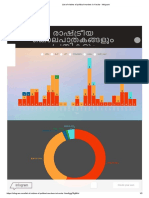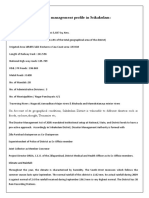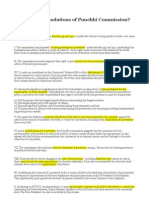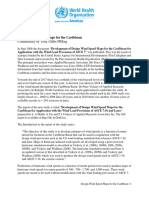Poster Publication 2
Poster Publication 2
Uploaded by
Aravind MenonCopyright:
Available Formats
Poster Publication 2
Poster Publication 2
Uploaded by
Aravind MenonOriginal Title
Copyright
Available Formats
Share this document
Did you find this document useful?
Is this content inappropriate?
Copyright:
Available Formats
Poster Publication 2
Poster Publication 2
Uploaded by
Aravind MenonCopyright:
Available Formats
See discussions, stats, and author profiles for this publication at: https://www.researchgate.
net/publication/355772218
ASSESSMENT OF POST-DISASTER RECOVERY FROM GAJA CYCLONE: A CASE
STUDY OF AFFECTED VILLAGES IN COASTAL REGION OF TAMIL NADU
Poster · January 2020
CITATIONS READS
0 148
3 authors:
Leo George Balasubramani K.
Central University of Tamil Nadu Central University of Tamil Nadu
8 PUBLICATIONS 26 CITATIONS 75 PUBLICATIONS 450 CITATIONS
SEE PROFILE SEE PROFILE
Dinabandhu Mahata
Central University of Tamil Nadu
12 PUBLICATIONS 24 CITATIONS
SEE PROFILE
Some of the authors of this publication are also working on these related projects:
Spatial Epidemiology and Public Health View project
CALL FOR BOOK CHAPTER ELSEVIER- Multi-Contributed book titled “INDIGENOUS PEOPLE AND NATURE: INSIGHTS FOR SOCIAL, ECOLOGICAL, AND TECHNOLOGICAL
SUSTAINABILITY.” View project
All content following this page was uploaded by Leo George on 30 October 2021.
The user has requested enhancement of the downloaded file.
ASSESSMENT OF POST-DISASTER RECOVERY FROM GAJA CYCLONE:
A CASE STUDY OF AFFECTED VILLAGES IN COASTAL REGION OF TAMIL NADU
Introduction: Methodology Study Area
A tropical cyclone is a regular event in the pre and post-monsoon season
over the Bay of Bengal.
Cyclone is one such disaster that intensifies and disrupts the normal daily
life of a community for longer period.
On 16th November 2018, the tropical Cyclone Gaja struck the southeast
coast of India it was a severe storm with excessive rainfall and very high
wind speed (100-120km/hour).
The Gaja cyclone had affected the millions of people, damaging properties,
livelihood and natural environment in the coastal region.
The cyclone had hit six districts -
The main objective of the study is to identify the track region of Gaja cy-
clone, analysis of vegetation covers changes before and after the cyclone
and assess the post disaster impacts. DATAS
The average population density of affected area is 986 persons/sq.km;
Surveyed villages 30 Total households are 24,492
Child population (0-6 age) is 9.60 % and literacy rate is 72.93 % (Census
2011) Sample 162 families
Results and Discussion
Physical Impact: Damage Assessment: Response and Relief: Steps taken to overcome
51 people killed NDVI shows that 21 % of thick vegetation Around 2,50,000 people were displaced to
1.273 lakh trees uprooted part reduced to 13 % after the cyclone 471 relief centres
4,43,622+ houses damaged Thousands of coconut palms were destroyed 80% received assistance from governments/NGO’s/
45,000+ electric poles uprooted About 80 % of the people have suffered charity societies etc.
450+ electricity sub-stations damaged from major damages
People suffered for drinking water Problems in Response
Relief Assistances
Few villages isolated without any
transportation
Preparedness:
Almost all (as much as 98%) got the
warning prior to the cyclone
71 % people responded that there is a
need to take proper precautionary / risk Post Disaster Recovery:
reduction measures 52% of the people had to stay without basic amenities for a month
Mode of warning before cyclone Assistant required for
2% of households faces still electricity problems
complete recovery
Only 19% of the cyclone-affected people fully recovered
36% of people took about 6 months for recovery
How long it took to recover Percentage of recovery
Categories of loss
Resources offered
Vulnerability Assessment:
Adiramapattinam, Muthupettai and
Kodaikadu are highly prone Without basic amenities
Challenges faced by women and children Types of challenges
Immediate needs
Recovered from electricity
problem
Conclusion
Leo George S., Balasubramani K., Dinabandhu Mahata, Sulochana Shekar The coastal inhabitants, agricultural crops and plantations were intensely affected by Gaja cyclone.
& Balasundareshwaran A. This study provides a scenario of post phase of Gaja cyclone through physical, economic and social dimensions.
Department of Geography, School of Earth Sciences, Central University of Tamil Nadu,
Thiruvarur - 610 005 The questionnaire survey comprehends the current situation of cyclone affected regions.
Corresponding Emails: georgeleo8@gmail.com, geobalas@cutn.ac.in The disaster in the deltaic coast of Tamil Nadu appeals for preparedness and mitigation in larger scale.
View publication stats
You might also like
- List of Victims of Political Murders in Kerala - InfogramDocument2 pagesList of Victims of Political Murders in Kerala - InfogramAravind MenonNo ratings yet
- MUNDADocument14 pagesMUNDARQ MirandaNo ratings yet
- Jagnoor-2019-Exploring The Impact, Response AnDocument10 pagesJagnoor-2019-Exploring The Impact, Response AnNoorie SyedNo ratings yet
- Disaster Resilient Housing at Sundarban, West Bengal - by Dakshata KoliDocument18 pagesDisaster Resilient Housing at Sundarban, West Bengal - by Dakshata KoliDakshata KoliNo ratings yet
- Для просмотра статьи разгадайте капчуDocument10 pagesДля просмотра статьи разгадайте капчуdipon sakibNo ratings yet
- Presentation 2 - ADocument34 pagesPresentation 2 - AKhiZra ShahZadNo ratings yet
- EARTHSCIDRAFTDocument4 pagesEARTHSCIDRAFTtranquilinogacus123No ratings yet
- 1537155697role of Disaster Governance in Disaster Risk Management - Mostofa KamalDocument24 pages1537155697role of Disaster Governance in Disaster Risk Management - Mostofa KamalMd Saiduzzaman shilonNo ratings yet
- Solar Water PurifierDocument10 pagesSolar Water Purifiernainwalhimanshu17No ratings yet
- Natural Disaster Report - SofiaDocument3 pagesNatural Disaster Report - SofiafeitanandwidNo ratings yet
- Hazards and Disasters ManagementDocument33 pagesHazards and Disasters ManagementumairbinsaadNo ratings yet
- EDN Lec Modules 1 19Document60 pagesEDN Lec Modules 1 19angelaebojo99No ratings yet
- Water Supply, Health and Vulnerability in Floods: by Jean MccluskeyDocument4 pagesWater Supply, Health and Vulnerability in Floods: by Jean MccluskeyJuan Diego Valdivia HerediaNo ratings yet
- Flood Preparedness and Utilization of Early Warning Systems Among Households in Selected Ood-Prone Areas in Tagum City, Davao Del NorteDocument15 pagesFlood Preparedness and Utilization of Early Warning Systems Among Households in Selected Ood-Prone Areas in Tagum City, Davao Del NortelilienesieraNo ratings yet
- Wash in Emergencies: Pakistan WASH Environment and The Emergency ContextDocument39 pagesWash in Emergencies: Pakistan WASH Environment and The Emergency ContextMohammad Bahram MonibNo ratings yet
- Swapandeep Kaur 1910941059 Research Paper 5Document11 pagesSwapandeep Kaur 1910941059 Research Paper 5Swapandeep KaurNo ratings yet
- Disaster Preparedness Among Barangay Barrera Residents An AssessmentDocument21 pagesDisaster Preparedness Among Barangay Barrera Residents An AssessmentBAYAN CHARLES GIAN C.100% (1)
- Chapter 30Document30 pagesChapter 30KathiresanMechanicNo ratings yet
- Good For EmergencyDocument24 pagesGood For Emergencybiosunil20067790No ratings yet
- Disaster Nursing NewspaperDocument2 pagesDisaster Nursing NewspaperZahNo ratings yet
- Indigineaou Knowledge in FloodDocument10 pagesIndigineaou Knowledge in Floodtiwari tuneNo ratings yet
- Essay 1Document3 pagesEssay 1api-373625036No ratings yet
- Characteristic of Riverbank Communities in Dealing With FloodsDocument4 pagesCharacteristic of Riverbank Communities in Dealing With FloodsEllida NovitaNo ratings yet
- DRRR Quarter 1 - Module 4Document3 pagesDRRR Quarter 1 - Module 4Shelly Ryn Saligumba90% (39)
- Health Impacts of Rural Flood and Community Coping Strategies in Northeast ThailandDocument8 pagesHealth Impacts of Rural Flood and Community Coping Strategies in Northeast ThailandJoecoNo ratings yet
- Ce423 Flood Control g2 3rd PrintDocument5 pagesCe423 Flood Control g2 3rd PrintAngelica FabianNo ratings yet
- Cyclones, Tsunamis, and Human HealthDocument10 pagesCyclones, Tsunamis, and Human HealthRUCOOLNo ratings yet
- Bhokalebaetal 2023 IOP Conf. Ser. Earth Environ. Sci. 1224 012016Document12 pagesBhokalebaetal 2023 IOP Conf. Ser. Earth Environ. Sci. 1224 012016CAROLINE GRACIANo ratings yet
- Disaster Mitigation and Management - Management Cycle 18CEO307TDocument41 pagesDisaster Mitigation and Management - Management Cycle 18CEO307Ta bNo ratings yet
- Antonio Christian Duilio AC1P2Document9 pagesAntonio Christian Duilio AC1P2Cristian GarciaNo ratings yet
- Cyclone Sheltre AssessmentDocument5 pagesCyclone Sheltre Assessmentzarrin.mrt1cs.ss207.1No ratings yet
- CHAPTER 1 Culture1Document36 pagesCHAPTER 1 Culture1limuelNo ratings yet
- Eloise Sitrep - 25 Jan-12 February 2021-FinalDocument3 pagesEloise Sitrep - 25 Jan-12 February 2021-Finaljiyanewilliam4No ratings yet
- Flood of - 20241020 - 211346 - 0000Document2 pagesFlood of - 20241020 - 211346 - 0000taslim.abdullah4949No ratings yet
- Research Notes On: Comprehensive Household Vulnerability and Risk Analysis To Natural Hazards (Coastal Region of Bangladesh)Document10 pagesResearch Notes On: Comprehensive Household Vulnerability and Risk Analysis To Natural Hazards (Coastal Region of Bangladesh)aftabbd5765No ratings yet
- Category 3 GuidebookDocument23 pagesCategory 3 GuidebookWorking GuyNo ratings yet
- Disaster Managment 1Document4 pagesDisaster Managment 1unknownNo ratings yet
- Uncovering The Root Causes and Far-Reaching Impacts of Floods and Landslides in Brooke's Point, PalawanDocument9 pagesUncovering The Root Causes and Far-Reaching Impacts of Floods and Landslides in Brooke's Point, PalawanPsychology and Education: A Multidisciplinary JournalNo ratings yet
- The Impacts of Typhoon Rolly in Barangay San Miguel Calabanga Camarines SurDocument30 pagesThe Impacts of Typhoon Rolly in Barangay San Miguel Calabanga Camarines SurHannah ChristiaNo ratings yet
- DP&PM Unit - 1Document22 pagesDP&PM Unit - 1G NIHANo ratings yet
- Vulnerability of Floodways Under Extreme Flood EventsDocument12 pagesVulnerability of Floodways Under Extreme Flood EventsCSSNo ratings yet
- Report Flood Group2Document15 pagesReport Flood Group2Angelica FabianNo ratings yet
- International Journal of Disaster Risk Reduction: Lyca G. Ipong, Elvira E. Ongy, Milagros C. BalesDocument9 pagesInternational Journal of Disaster Risk Reduction: Lyca G. Ipong, Elvira E. Ongy, Milagros C. BalesChristian Jeremy ManaloNo ratings yet
- Lecture 1&2 433Document54 pagesLecture 1&2 433Rakibul RummanNo ratings yet
- J Ijdrr 2015 04 003Document10 pagesJ Ijdrr 2015 04 003Ayesha SiddiquaNo ratings yet
- Ridzuan 2020 IOP Conf. Ser.: Earth Environ. Sci. 479 012009Document10 pagesRidzuan 2020 IOP Conf. Ser.: Earth Environ. Sci. 479 012009indera shafiqNo ratings yet
- Natural Disaster - An Overview - ScienceDirect TopicsDocument15 pagesNatural Disaster - An Overview - ScienceDirect TopicsJOYDEEP CHAKRAVORTYNo ratings yet
- Experiences, Coping Style, and Concerns of BSVAWA With Super-Typhoon OdetteDocument5 pagesExperiences, Coping Style, and Concerns of BSVAWA With Super-Typhoon OdetteIJELS Research JournalNo ratings yet
- Antonio Christian Duilio AC1P2-1Document9 pagesAntonio Christian Duilio AC1P2-1Cristian GarciaNo ratings yet
- 4_Disman_2024Document21 pages4_Disman_2024ha123hahohoNo ratings yet
- Fukushima Daiichi Nuclear DisasterDocument16 pagesFukushima Daiichi Nuclear DisasterVishal Reddy BommineniNo ratings yet
- Bangladesh Government PresentationDocument31 pagesBangladesh Government PresentationKuheli ChowdhuryNo ratings yet
- Response To Nepal's Earthquake: Ten Lessons From EvaluationsDocument4 pagesResponse To Nepal's Earthquake: Ten Lessons From EvaluationsIndependent Evaluation at Asian Development BankNo ratings yet
- Introduction To Floods and CyclonesDocument7 pagesIntroduction To Floods and CyclonesVedPrakash BamnawatNo ratings yet
- Disaster NursingDocument52 pagesDisaster NursingJemima RequelmanNo ratings yet
- Iom Pakistan - External Sitrep 3 - One Year Responding To The Floods v3Document11 pagesIom Pakistan - External Sitrep 3 - One Year Responding To The Floods v3Sadaqat UllahNo ratings yet
- Disaster Readiness and Risk ReductionDocument3 pagesDisaster Readiness and Risk ReductionCamille BaylonNo ratings yet
- Draft On Disaster ManagementDocument11 pagesDraft On Disaster ManagementsravyaNo ratings yet
- D1 02 ICIMOD Harikrishna Resilience DRR HinduKush 06feb2013Document25 pagesD1 02 ICIMOD Harikrishna Resilience DRR HinduKush 06feb2013dipankarpatnaikNo ratings yet
- 998 2095 07 28 15BR0 - enDocument13 pages998 2095 07 28 15BR0 - enabderraoufdob2No ratings yet
- Ams - e Upstox SignedDocument2 pagesAms - e Upstox SignedAravind MenonNo ratings yet
- Article 1661854387Document4 pagesArticle 1661854387Aravind MenonNo ratings yet
- Mirae Asset Nyse Fang EtfDocument2 pagesMirae Asset Nyse Fang EtfAravind MenonNo ratings yet
- Essay On Liberalization and Its Impact On The Indian EconomyDocument8 pagesEssay On Liberalization and Its Impact On The Indian EconomyAravind MenonNo ratings yet
- Main Recommendations of Punchhi CommissionDocument2 pagesMain Recommendations of Punchhi CommissionAravind MenonNo ratings yet
- Arvind Menon (AIR 201 - CSE 2011) Shares His Success-StoryDocument10 pagesArvind Menon (AIR 201 - CSE 2011) Shares His Success-StoryAravind MenonNo ratings yet
- Answering The Questions.: Tier-I of The ExaminationDocument3 pagesAnswering The Questions.: Tier-I of The ExaminationAravind MenonNo ratings yet
- Solved Paper SSC Combined Graduate Level Prelim Exam Held On 16.05.2010 First SittingDocument21 pagesSolved Paper SSC Combined Graduate Level Prelim Exam Held On 16.05.2010 First SittingNaren N End NNo ratings yet
- 2.2 Flooding in PhilippinesDocument3 pages2.2 Flooding in PhilippinesainarifahNo ratings yet
- TyphoonDocument19 pagesTyphoonjeromeohdeleon17No ratings yet
- HabagatDocument2 pagesHabagatJuan CruzNo ratings yet
- EMERGENCY PREPAREDNESS AND RESPONSE Report For Typhoon OdetteDocument10 pagesEMERGENCY PREPAREDNESS AND RESPONSE Report For Typhoon OdetteCharles Rommel TadoNo ratings yet
- Public Weather Advisory FerdieDocument1 pagePublic Weather Advisory FerdieRJay JacabanNo ratings yet
- Facts About Tropical CyclonesDocument3 pagesFacts About Tropical CyclonesElvis100% (1)
- Numerical Simulation of Storm Tides Generated by Historical Typhoons Along Dagupan City CoastlineDocument32 pagesNumerical Simulation of Storm Tides Generated by Historical Typhoons Along Dagupan City Coastlinecatherine faithNo ratings yet
- LESSON 7 Hydrometeorological HazardsDocument28 pagesLESSON 7 Hydrometeorological HazardsAngelica PoblacionNo ratings yet
- Typhoon QuizDocument3 pagesTyphoon QuizBrent BoniorNo ratings yet
- LAS Week 4 Grade 8 Science (1) (1) - PidoDocument6 pagesLAS Week 4 Grade 8 Science (1) (1) - PidoElizabeth Mata Monares TocayonNo ratings yet
- Gale#27Document1 pageGale#27Mark Jasper InocencioNo ratings yet
- Typhoon Ambo Narrative ReportDocument2 pagesTyphoon Ambo Narrative ReportDANNo ratings yet
- ATFM Daily PlanDocument6 pagesATFM Daily PlanbazingaNo ratings yet
- Situational Report #6 Tropical Depression Aghon May 27 2024Document9 pagesSituational Report #6 Tropical Depression Aghon May 27 2024manila dilgncrNo ratings yet
- Typhoon g4Document31 pagesTyphoon g4Laiza RemasogNo ratings yet
- HK Weather Tomorrow - Google Search YesDocument1 pageHK Weather Tomorrow - Google Search Yesalimaniacs213No ratings yet
- Certification Ehap NhaDocument5 pagesCertification Ehap NhasanchezarchlaurenceNo ratings yet
- Weather Prediction Center (WPC) Home PageDocument1 pageWeather Prediction Center (WPC) Home PageLuis YanezNo ratings yet
- TCB#13 NikaDocument4 pagesTCB#13 NikascdantolinoNo ratings yet
- BMKG-WeatherForecast - PHE WMO (PHE-5) - 26072023-PMDocument7 pagesBMKG-WeatherForecast - PHE WMO (PHE-5) - 26072023-PMZendy Randy PradikaNo ratings yet
- BNBC-2006 WIND Calculation PDFDocument7 pagesBNBC-2006 WIND Calculation PDFFauziah AminatunNo ratings yet
- Hurricane Miriam Tropical Storm JoanDocument8 pagesHurricane Miriam Tropical Storm JoanSana MerNo ratings yet
- Joross Cleven Miguel Ruado: Tropical Cyclone Wind SignalsDocument2 pagesJoross Cleven Miguel Ruado: Tropical Cyclone Wind SignalsHelen SabuquelNo ratings yet
- English ArticleDocument2 pagesEnglish ArticlestellaNo ratings yet
- Science - 8 - q2 - wk5 - Trace The Path of Typhoons That Enters The Par Using Map and Tracking DataDocument9 pagesScience - 8 - q2 - wk5 - Trace The Path of Typhoons That Enters The Par Using Map and Tracking DataAileen Ocampo50% (2)
- Lesson 1: The Philippine Area of ResponsibilityDocument5 pagesLesson 1: The Philippine Area of ResponsibilityMaria Cristina Delmo100% (1)
- Design Wind Speed Maps For The CaribbeanDocument55 pagesDesign Wind Speed Maps For The CaribbeanHCStepNo ratings yet
- Name: Alex Kate C. Dela Date: January 05, 2020Document2 pagesName: Alex Kate C. Dela Date: January 05, 2020kassy yeonNo ratings yet
- Week 5 Activities LongDocument1 pageWeek 5 Activities LongJovilyn JardielNo ratings yet
- StormGeo Ras Tanura Area 2024070310Document4 pagesStormGeo Ras Tanura Area 2024070310navalkarthiNo ratings yet


































































































